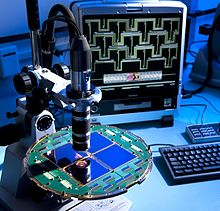BICEP
BICEP (Background Imaging of Cosmic Extragalactic Polarization) – seria eksperymentów dotyczących mikrofalowego promieniowania tła. Mają one na celu pomiar polaryzacji promieniowania tła, a w szczególności pomiar polaryzacji typu B. W eksperymentach biorą udział trzy generacje instrumentów: BICEP1, BICEP2 oraz Keck. BICEP3 jest w fazie konstrukcji. W marcu 2014 roku eksperymenty potwierdziły istnienie pierwszego typu polaryzacji typu B na poziomie Jednak w opublikowanym we wrześniu 2014 roku przez zespół pracujący przy eksperymencie Planck preprincie stwierdzono, że metodyka postępowania przy pomiarze w eksperymencie BICEP nie pozostawia „czystego” okna, w którym można by dokonać pomiaru modów B bez odjęcia emisji szumu[1].
| Instrument | Początek | Koniec | Częstotliwość | Rozdzielczość | Detektory (w pikselach) |
|---|---|---|---|---|---|
| BICEP | 2006 | 2008 | 100 GHz | 0,93° | 50 (25) |
| 150 GHz | 0,60° | 48 (24) | |||
| BICEP2 | 2010 | 2012 | 150 GHz | 0,52° | 500 (250) |
| Keck | 2011 | 2011 | 150 GHz | 0,52° | 1488 (744) |
| 2012 | 2012 | 2480 (1240) | |||
| 2013 | – | 1488 (744) | |||
| 100 GHz | 992 | ||||
| BICEP3 | 2013 | – | 95 GHz | 0,37° | 2560 (1280) |
Zobacz też
Przypisy
- ↑ [1409.5738] Planck intermediate results. XXX. The angular power spectrum of polarized dust emission at intermediate and high Galactic latitudes, „Cosmology and Nongalactic Astrophysics (astro-ph.CO) + A&A 586, A133 (2016)”, arxiv.org, DOI: 10.1051/0004-6361/201425034, arXiv:1409.5738 [dostęp 2017-12-02] (ang.).
Bibliografia
- http://bicepkeck.org/ [dostęp 2014-03-25]
Media użyte na tej stronie
Superconducting Detectors for Study of Infant Universe
http://www.jpl.nasa.gov/spaceimages/details.php?id=PIA17993
http://www.jpl.nasa.gov/news/news.php?release=2014-082
The BICEP2 telescope at the South Pole uses novel technology developed at NASA's Jet Propulsion Laboratory in Pasadena, Calif. The focal plane shown here is an array of devices that use superconductivity to gather, filter, detect, and amplify polarized light from the cosmic microwave background -- relic radiation left over from the Big Bang that created our universe.
The microscope is showing a close-up view of one of the 512 pixels on the focal plane, displayed on the screen in the background.
Each pixel is made from a printed antenna that collects polarized millimeter-wavelength radiation, with a filter that selects the wavelengths to be detected. A sensitive detector is fabricated on a thin membrane created through a process called micro-machining.
The antennas and filters on the focal plane are made from superconducting materials. An antenna is seen on the close-up shot in the background with the green meandering lines.
The detector uses a superconducting film as a sensitive thermometer to detect the heat from millimeter-wave radiation that was collected by the antenna and dissipated at the detector. A detector is seen on the close-up shot in the background to the right of the pink square.
Finally, a tiny electrical current from the sensor is measured with amplifiers on the focal plane called SQUIDs (Superconducting QUantum Interference Devices), developed at National Institute of Standards and Technology, Boulder, Colo. The amplifiers are the rectangular chips on the round focal plane.
The focal planes are manufactured using optical lithography techniques, similar to those used in the industrial production of integrated circuits for computers.
